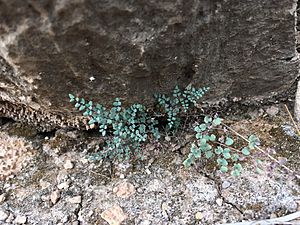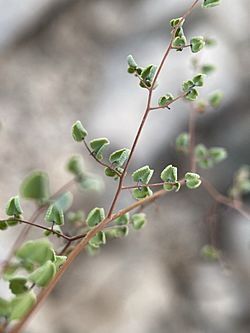Small-leaf false cloak fern facts for kids
Quick facts for kids Small-leaf false cloak fern |
|
|---|---|
 |
|
| Argyrochosma microphylla growing in a rocky crevice | |
| Conservation status | |
| Scientific classification | |
| Genus: |
Argyrochosma
|
| Species: |
microphylla
|
| Synonyms | |
|
|
Argyrochosma microphylla, also known as the small-leaf false cloak fern, is a type of fern. It grows naturally in New Mexico, Texas, and northern Mexico. This fern likes to grow on limestone rocks and cliffs.
Its leaves are divided into many tiny parts, which often fold in half when the fern gets dry. Unlike some other ferns in its family, Argyrochosma microphylla does not have a white powder on the underside of its leaves. Scientists first described this fern in 1869. Later, in 1987, it was moved into a new group of ferns called Argyrochosma, which means "false cloak ferns". This was done to show they are different from the "cloak ferns" (Notholaena).
Contents
What Does Argyrochosma microphylla Look Like?
This fern has a short, underground stem called a rhizome. Thin, brown scales cover this stem. The leaves grow close together from the rhizome.
The leaves can be from 7 to 25 centimeters (about 3 to 10 inches) long. Each leaf has a stalk, called a stipe, which is usually reddish-brown and makes up about one-third to one-half of the leaf's total length. The main part of the leaf, called the blade, is shaped like a triangle or an oval. It is divided into many smaller sections. At its widest part, the leaf blade is cut into three or four levels of smaller parts.
The leaf tissue is a gray-green color and feels like leather. You can't easily see the veins from the top of the leaf. The leaves do not have hairs or scales. Also, they don't have the white powder (called farina) that many other ferns in this group have.
When the fern is ready to reproduce, it forms tiny spore cases called sporangia. These sporangia are found close to the edges of the leaf segments. They form a narrow band about 1 millimeter (0.04 inches) wide. The leaf segments often curl or bend under, which helps to hide and protect the sporangia. Each sporangium holds 64 spores. A. microphylla reproduces sexually and has 54 chromosomes.
The small leaf parts and a shallow groove on the leaf's main stem help tell A. microphylla apart from other ferns in its group. Some other ferns, like A. fendleri, have zig-zag stems, but they also have white powder, which A. microphylla does not.
How Scientists Named This Fern
This fern was first described in 1869 by Max Kuhn. He named it Pellaea microphylla. The name microphylla means "small-leaved," which fits the fern's tiny leaf parts. Before this, it was often grouped with another fern, P. pulchella.
Later, in 1987, a scientist named Michael D. Windham moved this fern into a new group called Argyrochosma. This new group was created after studies showed that these ferns were different enough to have their own genus. So, the fern was renamed A. microphylla.
In 2018, another scientist, Maarten J. M. Christenhusz, suggested moving it to the genus Hemionitis, calling it H. vooshvazool. The name "Vooshvazool" comes from a character in the book The Neverending Story. However, many scientists still use the name Argyrochosma microphylla.
Studies have shown that A. microphylla is closely related to A. formosa. These two ferns, along with A. jonesii and A. lumholtzii, do not have the white powder on their leaves. Scientists believe their common ancestor split off from the rest of the fern family before the ability to produce this powder developed.
Where This Fern Lives
Argyrochosma microphylla is found in the United States in southeastern New Mexico and the Trans-Pecos region of Texas. It has also been found in places like Brazos County, Texas and Bernalillo County, New Mexico. In Mexico, it grows in northern states from Sonora to Nuevo León and south into Zacatecas.
This fern likes to grow on rocky limestone hillsides, cliffs, and talus slopes (slopes made of broken rocks). It can be found at heights from 300 to 2100 meters (about 980 to 6,900 feet) above sea level.
Growing Argyrochosma microphylla
If you want to grow this fern, it prefers a lot of light. It also needs soil that drains well, meaning water doesn't sit in it. Sandy soil might be good, and it might like soil with a high pH (which means it's more alkaline).
See also
 In Spanish: Argyrochosma microphylla para niños
In Spanish: Argyrochosma microphylla para niños



